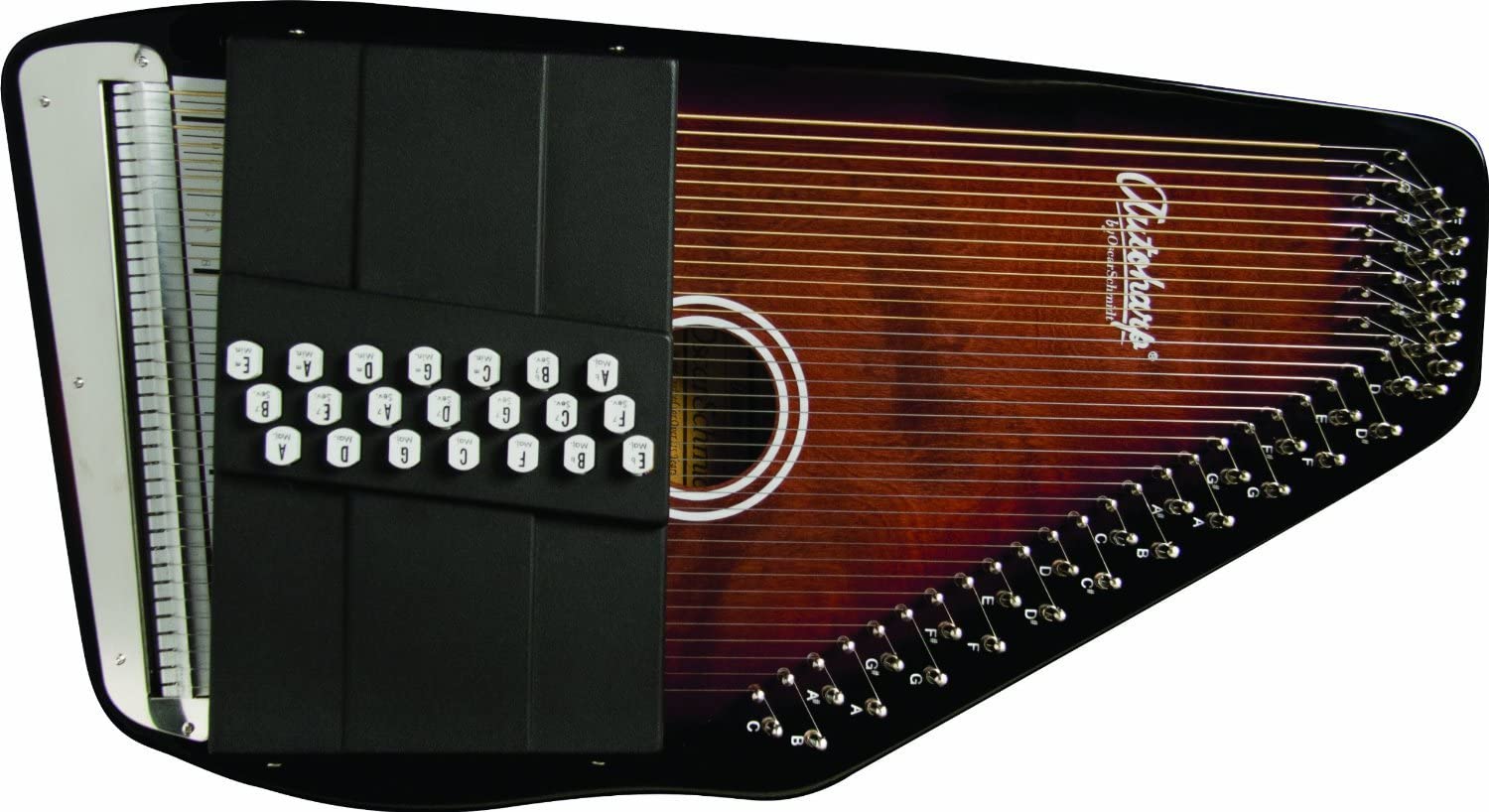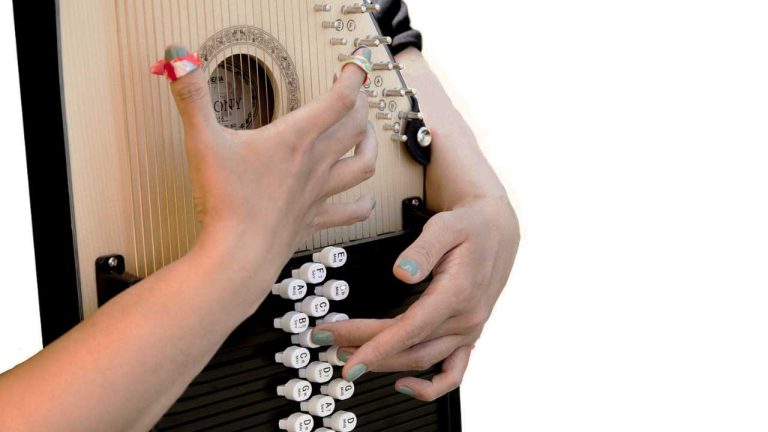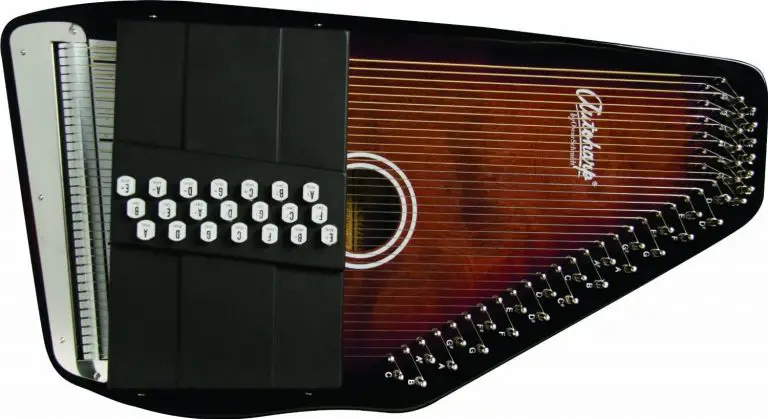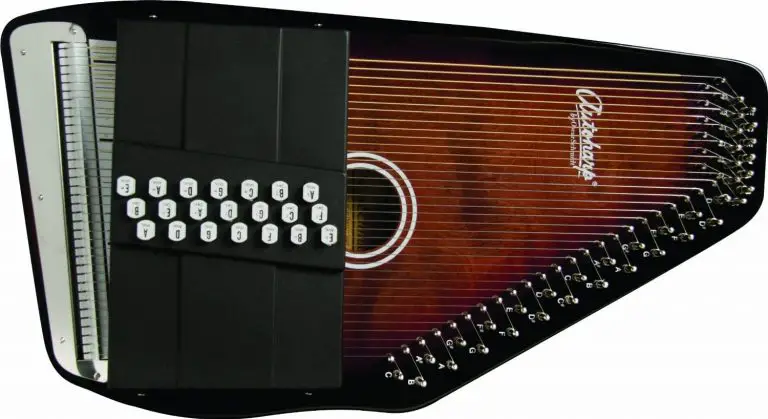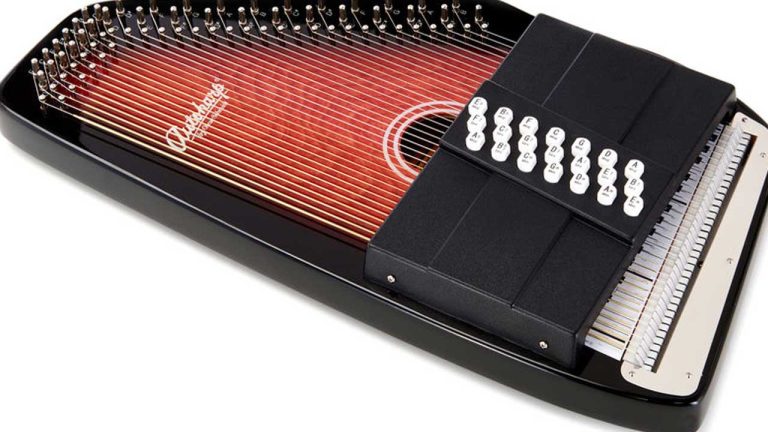What Is the Autoharp Made Of: Exploring Its Materials and Craftsmanship
Folkstrings.com is reader-supported. When you buy through links on our site, we may earn a small commission.
The autoharp is a stringed instrument that is beloved for its simplicity and the charming sounds it can produce. These sounds have captivated music enthusiasts for generations.
At its core, an autoharp is typically made from wood, which forms the body and the soundboard, providing the resonance needed for the instrument’s unique tone. The number of strings can vary, but they are commonly made of steel and stretch across the soundboard. Felted bars serve as dampers to create chords when pressed.
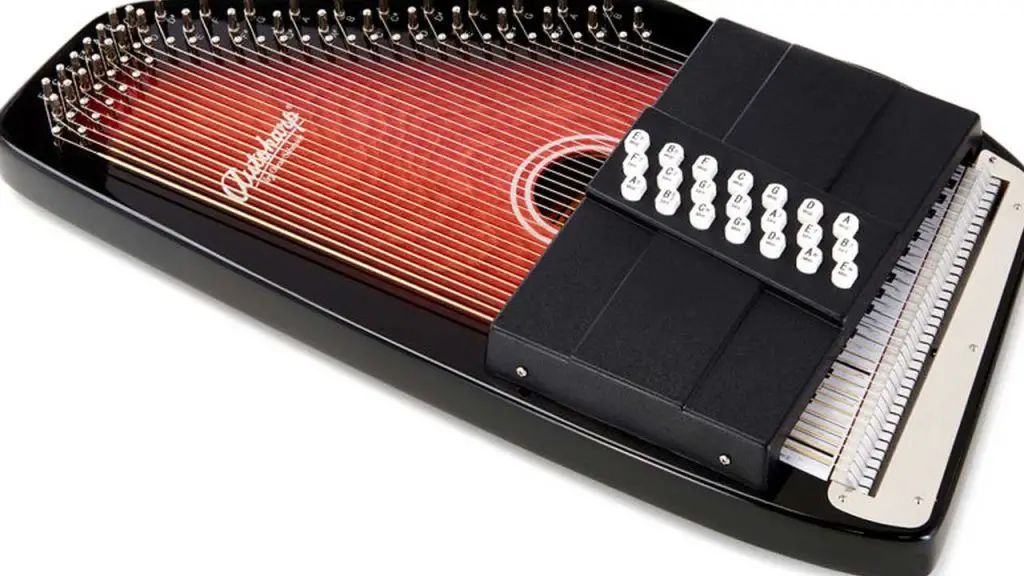
My fascination with the autoharp began when I learned that the materials used in its construction are key to its sonic character. The wood choice, such as maple, spruce, or other quality tonewoods, influences the instrument’s durability and sound quality. High-quality woods are sought after for their ability to produce a clearer and more resonant tone.
Additionally, the fine craftsmanship that goes into creating the instrument ensures that each autoharp has its own distinctive voice, shaped by the materials and the maker’s skill.
Key Points
- The autoharp’s warm, distinctive sound is a result of the quality wood and steel strings used in its construction.
- The materials and skilled craftsmanship are crucial in giving each autoharp its unique tonal character.
- My journey with the autoharp has revealed the importance of design and construction in contributing to the instrument’s place in music and culture.
Table of Contents
History and Evolution
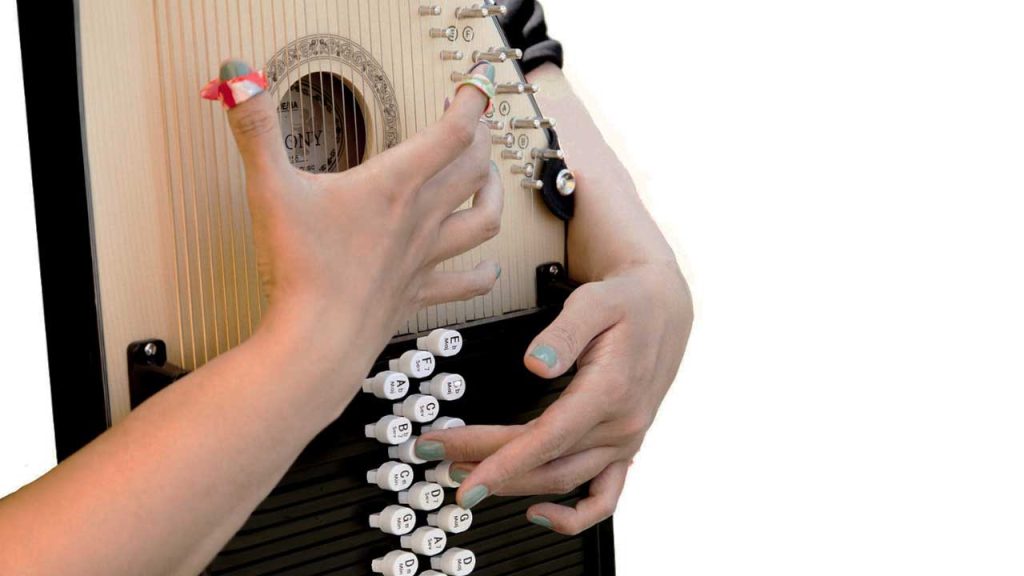
My investigation into the autoharp’s past took me through a fascinating journey of innovation and cultural adoption. Initially, the autoharp’s story began in the late 19th century with Charles F. Zimmermann, a German immigrant to the United States. He developed an instrument suited to the music education market and successfully obtained a patent for it in 1882. Zimmermann called his creation the “autoharp,” although the term would later describe a variety of chorded zithers.
The autoharp, as I discovered, has a German cousin known as the “Volkszither,” developed by Karl August Gütter prior to Zimmermann’s patent. Although similar, it’s crucial to note the differences between these instruments, particularly in their mechanical chord bars.
In the hands of Oscar Schmidt, the autoharp’s production and popularity soared. Oscar Schmidt Inc., formed in the early 1900s, became a leading manufacturer, helping the instrument become a staple in American folk music. It wasn’t just the quality of Schmidt’s instruments that secured their place in history; his business acumen ensured that autoharps found their way into homes and schools across America.
Trademark proceedings in the 1920s were telling of the autoharp’s success; the term had become synonymous with the instrument itself, blurring lines between brand and product genre.
As I delved into the role of the autoharp in American music, its appearance on stages such as the Grand Ole Opry affirmed its influence. Performers plucked and strummed, drawing solemn tones and vibrant backdrop to tales of Appalachian life.
Fast forward to the modern era, the autoharp still resonates with music enthusiasts, evolving with electronic capabilities and appealing to a broad audience. Its journey from Zimmermann’s patent to an emblem of American cultural heritage is a testament to its adaptability and enduring charm.
Design and Construction
In my exploration of the autoharp, I’ve found that its design and craftsmanship are key to its unique sound. From the selection of materials to the precision of its components, every aspect is critical.
Materials and Components
The body of an autoharp is traditionally made from wood, which forms the main structure and soundboard. The soundboard, typically spruce or another resonant wood, is vital as it directly influences the quality of the sound.
Metal is also a crucial material, used for components such as the tuning pins. The pins are inserted into a pin-block, usually made of hard maple for durability. For the playing experience, plastic may be used in the design of the chord bars, while felt is used to mute certain strings when a chord is played. Each string, often made of steel, interacts with the soundboard to produce the instrument’s rich tones.
| Component | Material |
|---|---|
| Soundboard | Wood (e.g., Spruce) |
| Tuning Pins | Metal (e.g., Steel) |
| Pin-block | Wood (e.g., Maple) |
| Chord Bars | Plastic |
| String Dampener | Felt |
| Strings | Metal (Steel) |
Variations
Autoharps can feature different numbers of strings, typically ranging from 15 to 37, which influence the range and complexity of the instrument. Some modern autoharps include a metal plate that adds to the structural integrity and can affect tone quality.
Moreover, various woods such as maple, walnut, or mahogany are chosen for their sonic qualities, weight, and appearance. Thus, my experiences reveal that an autoharps design can vary significantly, which allows for customization and personal preference.
Strumming Mechanism
At the heart of the autoharp is the strumming mechanism, comprising strings, chord bars, and a series of springs and felts.
Strumming involves pressing the chord bars, which brings the attached felt into contact with the strings, muting the non-chord tones. The coordination of this system is crucial; it relies on the precision of the components, such as the tension of the springs and the placement of the felt, to ensure the right strings are dampened.
Playing the Autoharp
When I first started playing the autoharp, I learned that it belongs to the zither family, which is a string instrument with a rich timbre and a wide variety of tuning capabilities. The standard autoharp is a rectangular instrument, often with 36 strings, providing a fully chromatic scale and an octave range from F2 to C6.
Tuning
I always make sure my autoharp is properly tuned. Each string corresponds to a different pitch, and tuning can be either diatonic, suitable for folk music, or fully chromatic, offering a wider selection of notes.
Chord Bars and Buttons
Chord bars are essential for playing the autoharp. They’re equipped with felt dampers that mute all strings except those that form the desired chord. To change chords, I press the chord bars—each indicates a different chord like major, minor, or dominant seventh.
- Pressing Techniques: Gently press the bar or button to avoid any unnecessary strain on the strings.
- Common Chords: Diatonically, you get major and minor chords; with a chromatically tuned autoharp, a greater variety of chords is available.
Strumming
Strumming or plucking the strings while pressing a chord bar produces a full chord. I hold the instrument against my chest in an upright position for a comfortable playing posture.
- Strum Patterns: Downward, upward, or a combination, similar to a guitar.
- Picking Techniques: Use fingers for plucking individual strings or a pick for full strums.
Ways to Play
I’ve met musicians who play the autoharp both diatonically, often in folk genres like bluegrass, and chromatically for a broader range of music. Legendary personalities like Maybelle Carter of The Carter Family revolutionized its use in American folk music.
Learning and Cost
For beginners, the autoharp is relatively easy to learn. The costs vary depending on quality, from budget-friendly models for learners to high-end ones for performers. There are 15-chord and 21-chord autoharps; the larger the variety of chords, the more flexibility in playing. Some autoharps feature a pickup that can be used to amplify the sound for live performances.
Autoharp in Culture and Music
The autoharp holds a special place in my heart as a vibrant facet of musical culture, especially within American music traditions. It’s a stringed instrument that employs a series of chord bars. This enables players like myself to strum chords with ease, making music accessible and enjoyable.
In the sphere of American music, the autoharp has a distinctive role. In particular, the autoharp has a distinctive role in the folk and bluegrass genres. The Carter Family, one of the pivotal groups in American folk music history, showcased the autoharp’s charm through Maybelle Carter’s playing. Her style and the family’s performances on the Grand Ole Opry significantly contributed to the instrument’s popularity.
I’ve always found folk music gatherings warm and welcoming. The autoharp is often at the center, as it blends seamlessly with instruments like the dulcimer, mandolin, and banjo. The texture of its sound adds richness to the acoustic mix that’s so characteristic of American folk music.
Here are brief notes about autoharps’ cultural contributions:
- Maybelle Carter: Popularized the autoharp in American folk music.
- Bluegrass: An integral instrument in bluegrass jam sessions.
- June Carter Cash: Continued the family legacy, sharing the autoharp with new generations.
- Innovation: Modern musicians are reinventing the autoharp’s role in contemporary genres, keeping it relevant and exciting.
For anyone yearning to be part of musical heritage, picking up an autoharp can be a first step into a broader world of heartfelt expression. It has been evolving right from the early 20th century to the present. It’s not just an instrument; it’s a bridge to a storied past, and for me, it’s been a joy to see it embraced in brand new ways.
Frequently Asked Questions
In this section, I’m going to shed light on some of the common curiosities surrounding the autoharp, from its construction to how it stands out from other instruments.
What materials are commonly used in autoharp construction?
Autoharps are primarily made from a variety of woods such as maple, spruce, or walnut for the body. The top, known as the soundboard, is often made from a softer wood like spruce to enhance sound quality, while the back may be constructed from a harder wood for durability. The strings are typically made from steel.
How does the sound of an autoharp compare to other string instruments?
The autoharp has a distinct chiming sound that is rich and resonant. It’s different from a guitar or a violin as it produces a fuller chord with a single strum due to its multiple strings and chord bars that press down to create the chords automatically.
Can you explain the mechanism that makes an autoharp work?
An autoharp uses a series of chord bars fitted with dampers, which, when pressed, mute all the strings except those that form the desired chord. By strumming across the strings, I can play full chords with ease, requiring only one finger to select the chord with the bar.
How does the autoharp differ from a harpsichord?
Fundamentally, autoharps and harpsichords are different; the autoharp is a string instrument played by strumming, and its chords are selected by a series of buttons.
On the other hand, a harpsichord is a keyboard instrument where strings are plucked by quills when keys are pressed.
What’s the difference between a zither and an autoharp?
A zither is a broader category of string instruments that often require more manual dexterity to play individual notes or chords.
The autoharp is a type of zither that’s equipped with chord bars that makes strumming chords simpler. Think of the autoharp as a zither with a built-in shortcut for playing chords.
Are there any challenges associated with learning to play the autoharp?
Learning to play the autoharp does come with its own set of challenges.
For example, you need to master the timing of pressing the chord bars while strumming. You also need to learn the proper hand technique.
However, many find the autoharp to be more accessible than other string instruments due to its chord bar mechanism.
Author Profile
-
Daniel Johnstone is an English writer with a love for stringed instruments from around the world.
He shares his love for these instruments through his writing for folkstrings.com, a website dedicated to all things related to folk string music.
Daniel's passion for music started at a young age, and he has since become an accomplished musician, playing guitar, cavaco, and recently, the harp.
His dedication to learning and sharing his knowledge of stringed instruments is evident in his insightful and engaging blog posts. Whether you're a seasoned musician or a beginner, Daniel's writing is sure to inspire and entertain you.
When he's not playing music or writing, you can find Daniel exploring new instruments and seeking out new sounds to share with his readers.
Latest entries
 AutoharpApril 4, 2024What Is the Autoharp Made Of: Exploring Its Materials and Craftsmanship
AutoharpApril 4, 2024What Is the Autoharp Made Of: Exploring Its Materials and Craftsmanship AutoharpApril 4, 2024Is Autoharp Easy to Play? Unveiling the Truth for Beginners
AutoharpApril 4, 2024Is Autoharp Easy to Play? Unveiling the Truth for Beginners AutoharpApril 4, 2024What Is an Autoharp Worth? Your Guide to Pricing and Value
AutoharpApril 4, 2024What Is an Autoharp Worth? Your Guide to Pricing and Value AutoharpApril 4, 2024Are Autoharp and Zither the Same Thing? Unraveling String Instrument Myths
AutoharpApril 4, 2024Are Autoharp and Zither the Same Thing? Unraveling String Instrument Myths
Affiliates:
This post may contain affiliate links that at no additional cost to you, the site may earn a small commission. We only recommend products we would use ourselves and all opinions expressed on this site are our own.
Accuracy Advice:
While we strive to provide up-to-date and accurate information, the content in this article may not reflect the most current research or medical guidelines. We encourage readers to do further research and consult with professionals for more personalized advice.
Our Recommendations:
The products and services mentioned in any of our articles are recommended based on our independent research and personal experience. We are not sponsored by any company. We aim to suggest products and services we believe are of high quality and could be beneficial to our readers.

